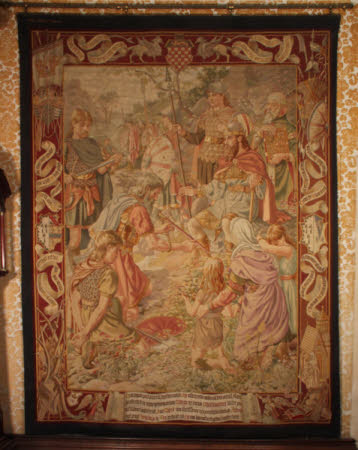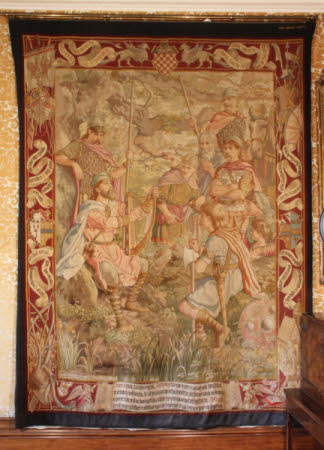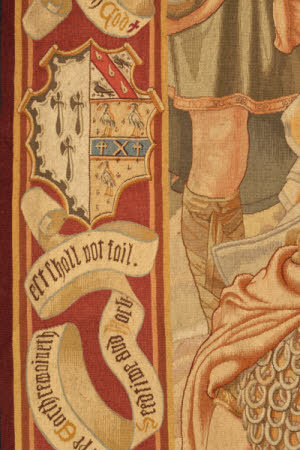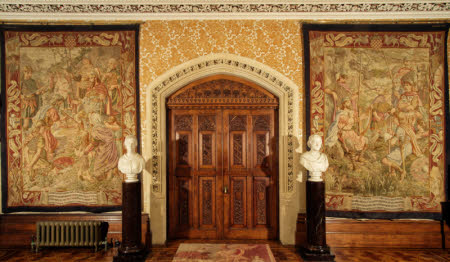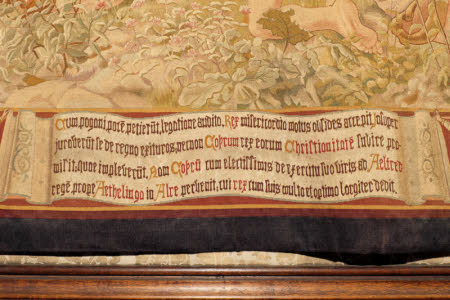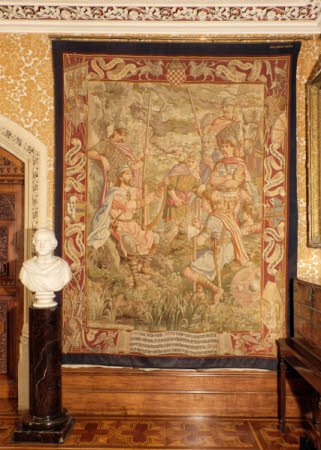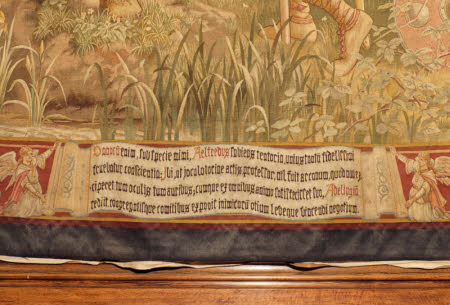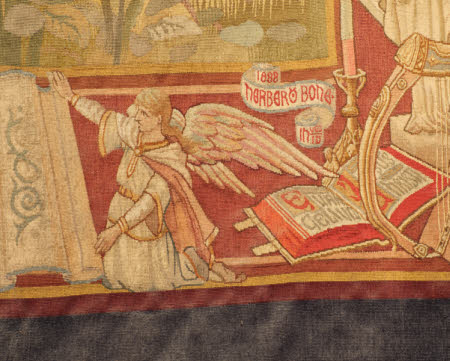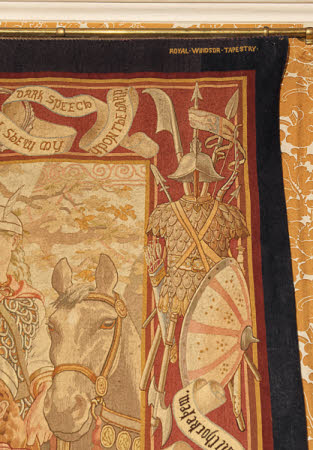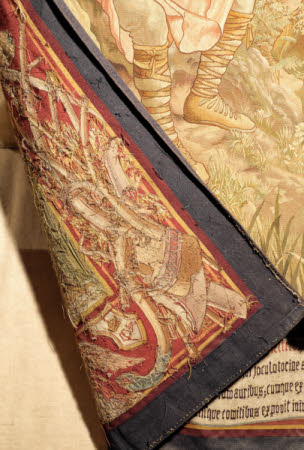History of King Alfred
Royal Windsor Tapestry Manufactory
Category
Tapestries
Date
circa 1887
Materials
Tapestry, wool, silk and cotton, 6 warps per cm
Place of origin
Old Windsor
Order this imageCollection
Tyntesfield, North Somerset
NT 33552
Summary
A set of two tapestries, wool and silk, 6 warps per cm, from the History of King Alfred, Windsor Tapestry Manufactory after a design by Herbert Bone, 1888.
Full description
The two ‘King Alfred’ tapestries at Tyntesfield tell the story of King Alfred’s expulsion of the Vikings from his kingdom of Wessex in the year 878. For later generations Alfred came to be a symbol of patriotism and piety, themes prominent in the tapestries. ‘King Alfred the Minstrel’ demonstrates the King’s cunning and determination to defeat the enemy, and ‘The Submission of Gothrum’ the power of his Christianity. The borders elaborate on two overarching themes: the impregnability of the English kingdom, and Alfred’s faith in God. The quote in the scroll at the top of the left hand border, “Back’d with god and with the seas which He hath given for fence impregnable”, comes from Shakespeare’s Henry VI Part 3 (Act 4, Scene 1), and is part of Hastings’s argument to Montagu against forming an alliance with France; it refers to England’s natural defence against invading powers, the sea. In the upper right hand border is another quote from Shakespeare, this time from the Bastard’s speech in the last lines of King John, again made in defiance of the French: “Come the three quarters of the world in armes and we shall shock them” [King John, Act 5, Scene 7]. The second two quotes are Biblical. The scroll in the lower left border reads “While the Earth remaineth Seed time and Harvest shall not fail” [Genesis 8.22], alluding to the constancy of God. The quote in the lower right hand border is taken from Exodus 35.35: “Them hath He filled with wisdom of the Heart to work all manner of work”. In addition each tapestry has a different quote from the Psalms in a scroll in the upper border, and a lengthy Latin inscription in the lower border. The latter are taken from two of the principal chronicles of the Anglo Saxon period, Asser’s Life of King Alfred, and William of Malmsbury’s Chronicle of the Kings of England (1125). These inscriptions both explain the subject of the tapestries and add an air of authenticity to the depictions of King Alfred’s exploits. The pictorial elements of the borders elaborate on elements of the story: the beautifully described Viking ship obviously refers to the Viking invasions; the trophy of arms, taking a Roman form but with Anglo Saxon details, underlines the military valour of Alfred and his army; the collection of farming implements may refer to the period of peace and prosperity that followed the expulsion of the Danes from the Kingdom of Wessex; and the chapel, saint and book in the lower right hand corner refer again to Alfred’s piety. These symbols are joined by a harp, which relates to the subject of ‘King Alfred the Minstrel’, and also a painter’s palette, perhaps introduced as a personal device by the designer Herbert Bone, whose signature appears on a scroll nearby. According to Miller the tapestries were commissioned by Anthony Gibbs (1841-1907) in memory of his parents, William (1790-1875) and Matilda (Miller 2003, p. 126). Their coats of arms appear in the centre of the left and right hand borders to each tapestry. Both were devout Anglicans and supporters of the Oxford Movement, so the pious theme of the tapestries would have been appropriate. The tapestry was made at the Royal Windsor Tapestry Manufactory, whose signature is woven into the upper galloon of each tapestry, and whose monogram, a gold crown over a letter W, appears on a white shield in the lower borders. The manufactory was founded in Old Windsor in 1876 by Henri C Henry, artistic adviser to the furniture company Gillow & Co., and Marcel Brignolas, who came to England with a group of French weavers from the ancient tapestry-producing town of Aubusson. Prince Leopold, Queen Victoria’s youngest son, supported the manufactory and became its president, while the Queen herself made several visits and in 1880 consented to its being termed ‘Royal’. The enterprise began with great success when a series of the ‘Merrie Wives of Windsor’ sent to the 1878 Paris Exhibition won a gold medal. Despite this promising start, and a number of royal commissions, by the time Prince Leopold died in 1884 the manufactory was already in severe financial difficulties. Further investment and commissions were sought and a number of important projects were undertaken in the later 1880s, but in 1890 the manufactory was forced to close. In choosing to commission tapestries from the Royal Windsor Manufactory Anthony Gibbs was probably influenced by his cousin Henry Hucks Gibbs, who was one of the guarantors of the workshop. Following Prince Leopold’s death in 1884 the workshop’s new patron, the Prince of Wales, appealed for new commissions to try and stave of closure. As a result Henry Hucks Gibbs commissioned tapestries for his house at Aldenham, and the commission for the ‘King Alfred’ tapestries, which are woven with the dates 1887 and 1888, was probably made at around the same time (Miller 2003, p. 126; Cullingham 1979, p. 4). Anthony Gibbs had previously bought three narrow tapestry panels after designs made for mosaics by Salviati for the Chapel at Tyntesfield (now kept in storage, nos. 18455, 18456, 18457). Scenes from English literature and history, like the Tyntesfield ‘King Alfred’ tapestries, were a speciality at the Windsor manufactory. The workshop also made a large number of views of Royal palaces, many of them Royal commissions, as well as landscapes and furnishing tapestries in the French style. A tapestry of ‘Europa and the Bull’ originally made for Henry Hucks Gibbs and now in the National Trust’s collection at Kingston Lacy is a rare example of a subject from classical mythology (no. 1258064). The ‘King Alfred’ tapestries were designed by Herbert Bone (1853-1931), whose name appears on a little scroll in the lower border of each tapestry. Bone joined the Windsor manufactory in 1879 and became one of its principal designers. A number of his preparatory drawings for the ‘King Alfred’ tapestries are in the Royal Library at Windsor, part of a collection of several hundred drawings presented to the library by his daughter. The collection also includes preparatory drawings for the ‘Salviati Mosaics’ tapestries of which there are examples at Tyntesfield, and the tapestries woven for Henry Hucks Gibbs at Aldenham, and correspondence about the tapestries between Bone and members of the Gibbs family (Millar 1995, vol. 1, pp. 98-9). According to Cullingham the two ‘King Alfred’ tapestries have been moved twice from their original position at Tyntesfield (Cullingham 1979, pp. 65-6) (Helen Wyld, 2013)
Provenance
Commissioned by Anthony Gibbs (1841-1907) for Tyntesfield and woven in 1888; thence by descent to Richard Gibbs, 2nd Baron Wraxall (1928-2001); Purchased by the National Trust from the estate of Lord Wraxall with the assistance of the NHMF and donations from members and supporters.
Makers and roles
Royal Windsor Tapestry Manufactory , workshop Herbert Alfred Bone (1853/4 - London 1931/2) , designer
References
Miller, 2003 James Miller, Fertile Fortune The Story of Tyntesfield, The National Trust 2003 Hall, 2002: Michael Hall. “Tyntesfield, Somerset.” Country Life 25 Apr. 2002: pp.114-117. Hall, 2002: Michael Hall. “Tyntesfield, Somerset.” Country Life 02 May 2002: pp.96-101. Millar, 1995: Delia Millar, The Victorian Watercolours and Drawings in the Collection of Her Majesty the Queen, 2 vols., London 1995 Cullingham, 1979: Gordon Graham Cullingham, The Royal Windsor Tapestry Manufactory, 1876-1890: an illustrated handlist of tapestries woven at the Old Windsor works, The Royal Borough of Windsor and Maidenhead 1979 Jane, 1908: Lionel Cecil Jane, Asser’s Life of King Alfred, London 1908 Bone, 1881: Herbert Bone, The Windsor Tapestries at Aldenham House, Herts., privately printed, London 1881 Bone, 1888: Herbert Bone, The Windsor Tapestries at Tyntesfield, privately printed, London 1888 Giles, 1847: J A Giles, William of Malmesbury’s Chronicle of the Kings of England. From the Earliest Period to the Reign of King Stephen, London 1847
